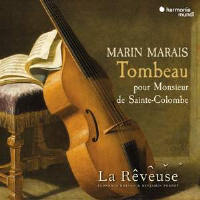Texte paru dans: / Appeared in: Pour s'abonner / Subscription information
|
|
|
Analyste: Bertil van Boer The title of this disc, Tombeau pour Monsieur de Sainte-Colombe, reflects the school of viol playing started by the shadowy but important figure of Sainte-Colombe, who was the major teacher of the instrument and whose skill was legendary. These works were compiled in the second book of the Pièces de viole in 1701 by Marin Marais as a tribute to his teacher, though they also included a short suite by Sainte-Colombe himself and a piece by Robert de Visée (c. 1650–1730). The former conforms to the format of the Baroque suite in its series of stylized dances. The first suite, in E Minor, begins with a rather funereal prelude, followed by stately if rather leathery Allemande, with its twisting thematic lines and thicker textures. The “Spanish” Sarabande bears a more than superficial resemblance to the “Folia,” a popular tune for variation at the time, while the Gigue tumbles about in a rather raucous display, half serious and half dramatic. This suite concludes with the Tombeau, a dreamy and languid set of variations which seem quite nostalgic in tone, though with clashing close harmonies that invoke the memory of Marais’s late teacher. It is gripping and yet sorrowful in one go. The second suite, in D Minor, mirrors the thoughtful tone of the first in the prelude, almost as if it were a continuation of the soft Tombeau. This is followed, however, by a rather insistent “Ballet en Rondeau,” and then a Polonaise, with its offbeat rhythms. The final movement here is entitled “Cloches ou Carillon,” with the pair of viols imitating the tolling of the bells, in between which one can discern a meandering theme and set of scurrying variations. The other works include a solidly composed Chaconne, in which the short variations are almost like an arrogant dance, and the G-Major Chaconne by Visée, which stomps about with some nice ornamentation. The latter is for Baroque guitar, and the use of the ground emerges clearly as the foundation of the repetitious variations. Sainte-Colombe’s concert piece begins with a light imitative Tombeau entitled Les Regrets; here is a slowly unfolding mournful theme and some quite gnarly harmonies in the pair of viols. Then comes a brief section (Carillon) in which the instruments imitate the pealing of bells, while the sequential “Appel de Charon” is solemn and prayerful, resulting in “Les Pleurs,” or tears, as if the invocation moves the ferryman of Hades, after which the musical conclusion evokes Elysium, a satisfactory Classical conclusion for a soul in the underworld. Marais’s A-Major Fantasia is characterized by both viols dancing around each other lightly, while his variations on “La Folia” develop from a straightforward depiction of the well-known tune into a set of increasingly complex variations. The disc concludes with Les voix humaines, a seeming paraphrase of a melancholic operatic lament, somewhat strophic in structure. The performance by the group La Rêveuse, consisting of viol players Florence Bolton and Emily Audoin, harpsichordist Carsten Lohff, and guitarist Benjamin Perrot, presents a nicely integrated ensemble. While the focus is on more solemn works in the program, the rich tones of the viols play out in a sensuous and sonorous duet that absorbs the listener. This alone gives the disc a well-rounded character for those who enjoy the heyday of the French viol as created by virtuosos from Sainte-Colombe to Forqueray. Well worth exploring. |
|




